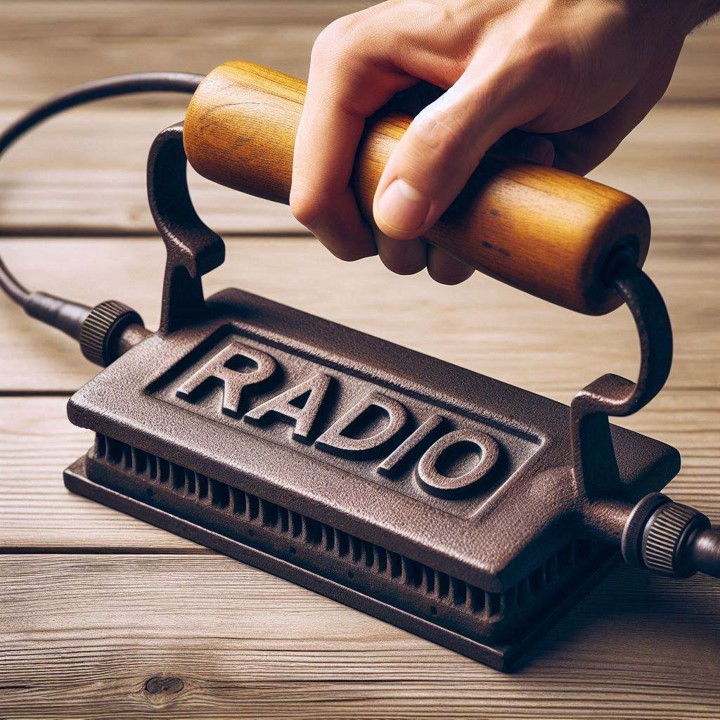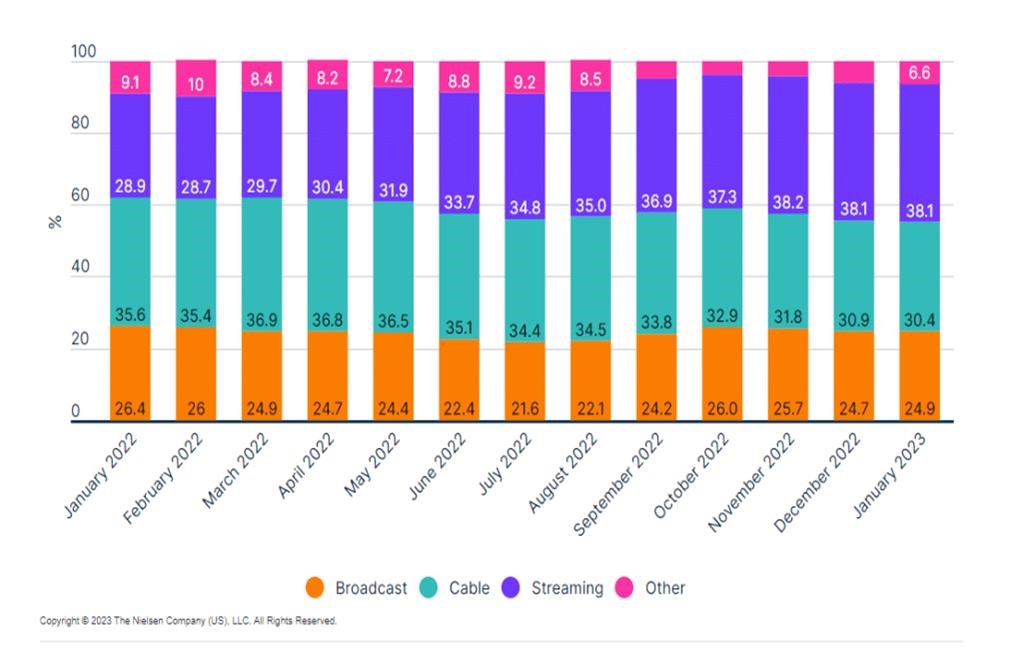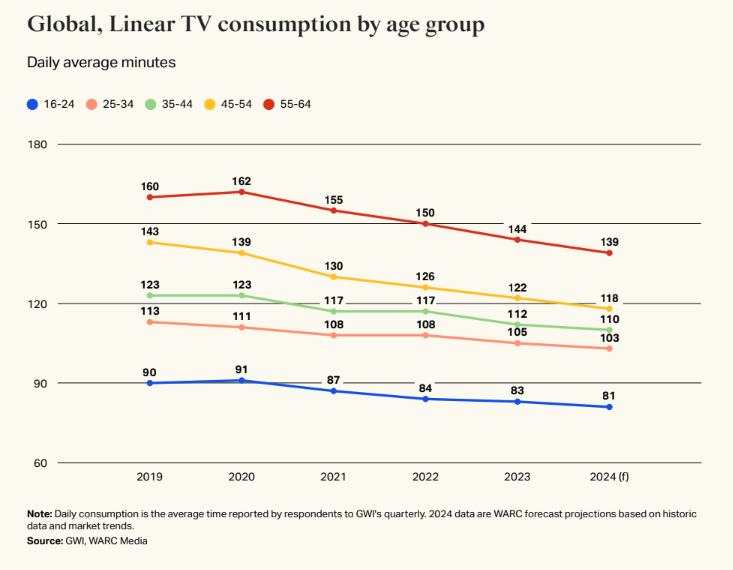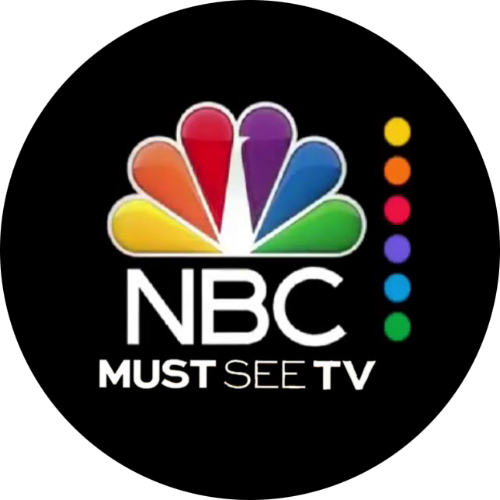
How much commercial television do you watch these days?
The data indicates that it’s less than ever before. Like broadcast radio, over the air television viewing has been trending steadily downward (the orange bars below) versus streaming (the blue bars), the platform where television has evolved to since Netflix stopped mailing out DVDs in red envelopes.

Just like in broadcast radio, there’s an important demographic story here, too. Unless you’re north of “the Big 6-0,” chances are good you’re not watching a whole lot of over-the-air television shows produced by the big four networks: CBS, NBC, ABC, and Fox.
For younger viewers, on-demand video streaming has been dominant for years now. Yet, for their parents (and grandparents), commercial TV still has upsides – familiar programming without any fees. The low cost of a digital antenna – the modern-day equivalent of “rabbit ears” – is all you need if you live in a decent sized metro area.
Yet even “mature” consumers – 55-64 year-olds – are gravitating away from broadcast television (red line below) in droves. And for the youngest media content consumers (blue line), linear TV makes up just a small part of their content menus.

But what is there to watch? For me, it’s down to Jeopardy (maybe once a week), CBS Sunday Morning (twice a month), and 60 Minutes (once a month…maybe). Aside from the wonderful CBS Sunday Morning, which combines other trappings of the weekend – coffee and the print edition of the Sunday New York Times – no shows on commercial television are what I’d call “Must See TV,” to steal a phrase – and a concept – from NBC-TV back in the go-go “Seinfeld” ’90s era.
The concept was simple – NBC racked up its best sitcoms on Thursday nights, branded the programming block “Must See TV,” and took it to the bank. It was brand extension at its best, promoting how easy it was for viewers to keep watching great NBC shows throughout the prime time hours. And it worked.
nights, branded the programming block “Must See TV,” and took it to the bank. It was brand extension at its best, promoting how easy it was for viewers to keep watching great NBC shows throughout the prime time hours. And it worked.
Today’s blog post is about a variation on the theme – finding ways to extend the life of a successful brand in need of a digital makeover. But it goes beyond that. How can producers, showrunners, or content creators use modern technology to infuse new life into traditional TV programming, and in the process, extend the life and relevance of the entity?
Ironically or perhaps not, that is precisely what’s going on right now at the venerable 60 Minutes, a show that’s become part of television news’ rich history. On for nearly six decades in its familiar Sunday night slot, CBS is proactively pursuing a “what’s next?” strategy for the show, leaning heavily into technology as the elixir that can not only extend the life of the show, but also can provide outreach to younger generations of consumers.
 Outside of radio broadcasting, every other media outlet and brand realizes the power of Gen Zs (and Gen Alphas, their younger sibs). A show like 60 Minutes may never entice them to watch the show on their CBS-TV local affiliate. But a podcast or TikTok? All within the realm of possibility.
Outside of radio broadcasting, every other media outlet and brand realizes the power of Gen Zs (and Gen Alphas, their younger sibs). A show like 60 Minutes may never entice them to watch the show on their CBS-TV local affiliate. But a podcast or TikTok? All within the realm of possibility.
A story that ran last week in The Hollywood Reporter – “Behind CBS’ Plan to Supercharge ’60 Minutes'” – by Alex Weprin, details the plan.
For its 57th season this fall, the network is pulling out all the stops to not just freshen up 60 Minutes, but to also revitalize the brand for extended audiences.
The plans include the following:
- A primetime special
- 90-minute extended episodes
- A podcast
- A FAST channel
- Use of the show’s extensive archives
One thing, however, won’t change: the brand’s foundational commitment to compelling longform storytelling.

While the network will no doubt be able to monetize some or all of the above mentioned content extensions, the strategy is to first develop great content for the core and emergent audiences that maintains the high-quality 60 Minutes standards. That’s how you strategically stretch a heritage brand.
You have to believe the network also put their research department to work, assessing the types of new content that would seemingly be both compelling and attractive to demographic groups that either drifted away from 60 Minutes or who have no idea what the brand is all about.
And they’re doing all of this before the show starts losing its talent, its ratings, and its place in the pop culture hierarchy. Why not extend the brand while it is still strong, viable, and top-of-mind?
So, let’s segue to radio, where too many great commercial and public radio shows were simply allowed to fade out in the sunset. Whether the catalyst was the retirement (or death) of a host or simply unpreparedness on the part of the station or network, too many great shows have simply died off because they didn’t have a succession plan.
The 60 Minutes example suggests old shows don’t have to go the route of public radio icons Car Talk and A Prairie Home Companion. In both cases, efforts were made to sustain these whimsical weekend shows, but too late in their life cycles to save or reinvent them.
Some of today’s best radio shows could make great use of the 60 Minutes brand extension paradigm. But this process needs to happen sooner in the life cycle rather than later if it has any chance of success.
It starts with conducting some research (the show’s email database should more than suffice), starting with focus groups for ideation and to get a handle on the brand’s top-of-mind health. A follow-up quantitative survey(s), again fielded among those already listening should provide assurances that new content extensions have more than a fighting chance of succeeding.
The beauty of the digital revolution is the branding choices available to any show, personality, or station. While 60 Minutes is tapping into several pathways that work well with its brand essence, its existing and available content, and its personnel, your radio brand hopefully brings its own set of strengths to the table.
What form might this take? Extended content could live on an HD2 channel, in a newsletter, a mobile app, a video series, a YouTube channel, a podcast, a social media scheme, or a website – to name just a few. The digital world makes it possible to produce many of these assets for a lot less money than it originally took to launch your AM or FM facility.
All of these 60 Minutes content plays may not bear fruit – or attract sufficient audience to rationalize a long existence. Some may not find their audience or their sources of revenue. So, they fall by the wayside, and CBS tries something else.
Brand extension in 2024 is a Wild Wild West of possibilities, many of which weren’t available or in existence when we entered this new millennium.
And in the big picture, it is no doubt more cost-effective to plot out brand extensions for existing shows than it is to totally invent new ones. With “classic” shows and brands, networks and producers have built-in audiences, eager to see where the brand is headed in the future. Contrast that with having to come up a while new concept in an environment where it has become increasingly difficult to generate mass appeal interest for pretty much anything.
Venerable brands also have track records with advertisers who are always looking for a sure thing.
Brand extension is a fine art and craft. Done well, it can sustain an existing brand stalwart. Done expertly, and it can spread its appeal to new generations of fans.
One last note: brand extension into new verticals opens up new talent doors. The host of the new podcast, 60 Minutes: A Second Look is CBS reporter Seth Doane. While not a cast member – yet – for the Sunday show, the producers believe he will be one day.
That’s another incentive to strategically brand extend existing shows – they can help a brand continue to grow talent.
Originally published by Jacobs Media








